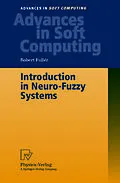Fuzzy sets were introduced by Zadeh (1965) as a means of representing and manipulating data that was not precise, but rather fuzzy. Fuzzy logic pro vides an inference morphology that enables approximate human reasoning capabilities to be applied to knowledge-based systems. The theory of fuzzy logic provides a mathematical strength to capture the uncertainties associ ated with human cognitive processes, such as thinking and reasoning. The conventional approaches to knowledge representation lack the means for rep resentating the meaning of fuzzy concepts. As a consequence, the approaches based on first order logic and classical probablity theory do not provide an appropriate conceptual framework for dealing with the representation of com monsense knowledge, since such knowledge is by its nature both lexically imprecise and noncategorical. The developement of fuzzy logic was motivated in large measure by the need for a conceptual framework which can address the issue of uncertainty and lexical imprecision. Some of the essential characteristics of fuzzy logic relate to the following [242]. . In fuzzy logic, exact reasoning is viewed as a limiting case of ap proximate reasoning. . In fuzzy logic, everything is a matter of degree. . In fuzzy logic, knowledge is interpreted a collection of elastic or, equivalently, fuzzy constraint on a collection of variables. . Inference is viewed as a process of propagation of elastic con straints. . Any logical system can be fuzzified. There are two main characteristics of fuzzy systems that give them better performance für specific applications.
Inhalt
Fuzzy Systems: An introduction to fuzzy logic; Operations on fuzzy sets; Fuzzy relations; The extension principle; The extension principle for n-place functions; Metrics for fuzzy numbers; Measures of possibility and necessity; Fuzzy implications; Linguistic variables; The theory of approximate reasoning; An introduction to fuzzy logic controllers; Defuzzification methods; Inference mechanisms; Construction of data base and rule base of FLC; The ball and beam problem; Aggregation in fuzzy system modeling; Averaging operators; Fuzzy screening systems; Applications of fuzzy systems.- Artificial Neural Networks: The perceptron learning rule; The delta learning rule; The delta learning rule with semilinear activation function; The generalized delta learning rule; Effectivity of neural networks; Winner-take-all-learning; Applications of artificial neural networks.- Fuzzy Neural Networks: Integration of fuzzy logic and neural networks; Fuzzy neurons; Hybrid neural nets; Computation of fuzzy logic inferences by hybrid neural net; Trainable neural nets for fuzzy IF-THEN rules; Implementation of fuzzy rules by regular FNN of Type 2; Implementation of fuzzy rules by regular FNN of Type 3; Tuning fuzzy control parameters by neural nets; Fuzzy rule extraction from numerical data; Neuro-fuzzy classifiers; FULLINS; Applications of fuzzy neural systems.- Appendix: Case study: A portfolio problem; Exercises.
